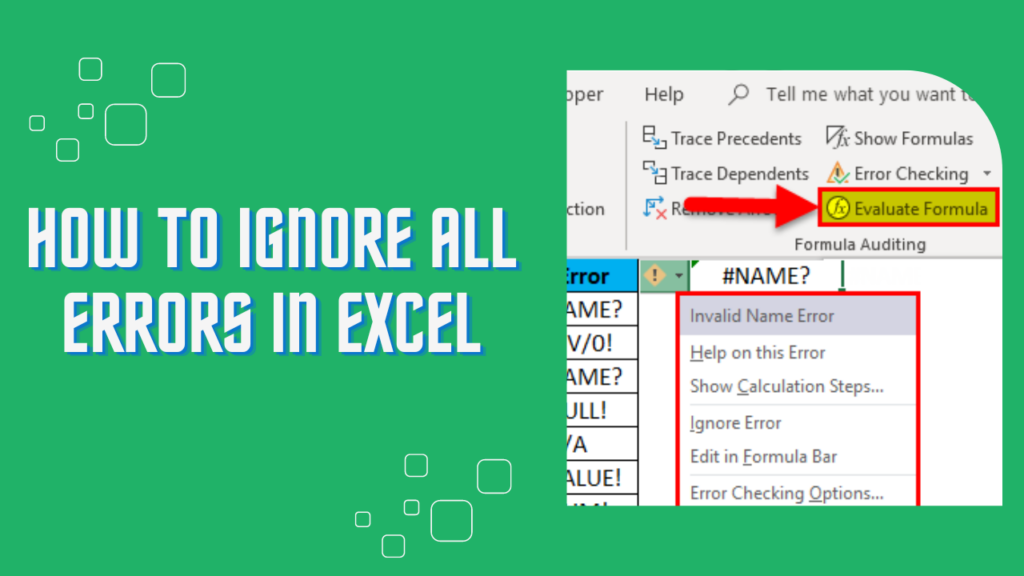Title: Ignoring Errors in Excel: Mastering Error Handling Techniques
Introduction:
Welcome to the Geek blog, where we delve into the realm of technology and explore its vast possibilities. In this article, we will guide you through the process of ignoring errors in Excel and help you become a pro at error handling. Get ready to unlock the power of Excel error management and elevate your data analysis skills to new heights. Let’s dive in!
Bypassing Errors in Excel: A Comprehensive Guide for Tech Enthusiasts
The article “Bypassing Errors in Excel: A Comprehensive Guide for Tech Enthusiasts” provides a detailed exploration of techniques to bypass errors in Microsoft Excel. This guide is specifically curated for tech enthusiasts who often encounter errors while working with Excel spreadsheets.
The bypassing errors feature in Excel allows users to overcome common issues such as division by zero, #VALUE!, and #REF! errors. By implementing practical strategies and formulas, tech enthusiasts can effectively troubleshoot and eliminate these errors from their spreadsheets.
One important technique discussed in the guide involves using the IFERROR function. This function enables users to specify a value or action to be taken if a formula returns an error. By incorporating the IFERROR function strategically in formulas, tech enthusiasts can replace error values with more meaningful outcomes, enhancing the accuracy and usability of their spreadsheets.
Another valuable concept covered in this comprehensive guide is the use of the ISERROR function. This function helps identify errors within formulas, allowing tech enthusiasts to create custom error-handling processes. By integrating the ISERROR function in conditional statements, users can take specific actions based on the presence of errors, ensuring data integrity and efficiency in their Excel workflows.
Moreover, the article delves into advanced techniques such as using VLOOKUP with IFERROR, debugging circular references, and utilizing Data Validation to prevent errors before they occur. These concepts further empower tech enthusiasts to optimize their Excel experience and streamline their data management processes.
In conclusion, “Bypassing Errors in Excel: A Comprehensive Guide for Tech Enthusiasts” offers a wealth of insights and practical approaches to handle errors in Microsoft Excel. By leveraging the discussed techniques, tech enthusiasts can confidently navigate Excel’s potential pitfalls and unlock the full potential of this powerful software tool.
Frequent Questions
How can I prevent error messages from displaying in Excel?
To prevent error messages from displaying in Excel, you can use the IFERROR function to display custom messages or leave the cell blank when an error occurs.
Is there a way to suppress all error warnings in Excel?
Yes, there is a way to suppress all error warnings in Excel. You can use the IfError function to handle errors and display custom messages or leave cells blank if an error occurs.
What steps can I take to ignore all errors and continue with calculations in Excel?
To ignore all errors and continue with calculations in Excel, you can use the ISERROR function combined with other functions like IF or IFERROR. This will allow you to specify alternative calculations or values when an error occurs. Another option is to adjust the calculation settings in Excel to bypass errors by going to Options, then Formulas, and selecting “Enable iterative calculation” or “Ignore error” under the Error Checking section.
In conclusion, knowing how to ignore all errors in Excel is a valuable skill for technology enthusiasts and professionals alike. By utilizing the IFERROR function and understanding various error types, users can enhance their efficiency and productivity when working with large datasets. Remembering to analyze the root causes of errors and implementing appropriate error handling techniques are crucial steps in harnessing the full potential of Excel as a powerful technological tool. So, embrace these strategies, streamline your workflow, and excel in your data management endeavors.



